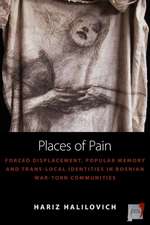The Central European Magdalenian: Regional Diversity and Internal Variability: Vertebrate Paleobiology and Paleoanthropology
Autor Andreas Maieren Limba Engleză Hardback – 23 sep 2015
| Toate formatele și edițiile | Preț | Express |
|---|---|---|
| Paperback (1) | 720.73 lei 6-8 săpt. | |
| SPRINGER NETHERLANDS – 29 oct 2016 | 720.73 lei 6-8 săpt. | |
| Hardback (1) | 636.35 lei 38-45 zile | |
| SPRINGER NETHERLANDS – 23 sep 2015 | 636.35 lei 38-45 zile |
Din seria Vertebrate Paleobiology and Paleoanthropology
- 15%
 Preț: 717.13 lei
Preț: 717.13 lei -
 Preț: 314.69 lei
Preț: 314.69 lei - 15%
 Preț: 724.12 lei
Preț: 724.12 lei - 18%
 Preț: 738.34 lei
Preț: 738.34 lei - 18%
 Preț: 741.37 lei
Preț: 741.37 lei - 15%
 Preț: 719.39 lei
Preț: 719.39 lei - 18%
 Preț: 635.90 lei
Preț: 635.90 lei -
 Preț: 411.04 lei
Preț: 411.04 lei - 20%
 Preț: 606.43 lei
Preț: 606.43 lei -
 Preț: 392.60 lei
Preț: 392.60 lei - 20%
 Preț: 617.45 lei
Preț: 617.45 lei - 15%
 Preț: 650.19 lei
Preț: 650.19 lei -
 Preț: 397.38 lei
Preț: 397.38 lei - 20%
 Preț: 619.33 lei
Preț: 619.33 lei -
 Preț: 391.27 lei
Preț: 391.27 lei -
 Preț: 431.73 lei
Preț: 431.73 lei -
 Preț: 433.47 lei
Preț: 433.47 lei - 24%
 Preț: 715.30 lei
Preț: 715.30 lei -
 Preț: 449.63 lei
Preț: 449.63 lei - 24%
 Preț: 763.00 lei
Preț: 763.00 lei - 15%
 Preț: 715.31 lei
Preț: 715.31 lei - 20%
 Preț: 631.43 lei
Preț: 631.43 lei - 18%
 Preț: 792.19 lei
Preț: 792.19 lei -
 Preț: 380.72 lei
Preț: 380.72 lei - 20%
 Preț: 604.45 lei
Preț: 604.45 lei - 15%
 Preț: 708.75 lei
Preț: 708.75 lei -
 Preț: 404.29 lei
Preț: 404.29 lei - 24%
 Preț: 645.20 lei
Preț: 645.20 lei -
 Preț: 383.94 lei
Preț: 383.94 lei - 18%
 Preț: 898.13 lei
Preț: 898.13 lei -
 Preț: 403.75 lei
Preț: 403.75 lei
Preț: 636.35 lei
Preț vechi: 837.31 lei
-24% Nou
Puncte Express: 955
Preț estimativ în valută:
121.76€ • 127.13$ • 100.78£
121.76€ • 127.13$ • 100.78£
Carte tipărită la comandă
Livrare economică 31 martie-07 aprilie
Preluare comenzi: 021 569.72.76
Specificații
ISBN-13: 9789401772051
ISBN-10: 9401772053
Pagini: 455
Ilustrații: XXVIII, 455 p. 163 illus.
Dimensiuni: 210 x 279 x 35 mm
Greutate: 1.32 kg
Ediția:1st ed. 2015
Editura: SPRINGER NETHERLANDS
Colecția Springer
Seria Vertebrate Paleobiology and Paleoanthropology
Locul publicării:Dordrecht, Netherlands
ISBN-10: 9401772053
Pagini: 455
Ilustrații: XXVIII, 455 p. 163 illus.
Dimensiuni: 210 x 279 x 35 mm
Greutate: 1.32 kg
Ediția:1st ed. 2015
Editura: SPRINGER NETHERLANDS
Colecția Springer
Seria Vertebrate Paleobiology and Paleoanthropology
Locul publicării:Dordrecht, Netherlands
Public țintă
ResearchCuprins
Introduction to the Central European Magdalenian–Area, Corpus and Major Questions.- Part I: Methodological and Theoretical Framework.- Collecting Data for Large-Scale, Literature-Based Studies.- Theoretical Framework.- Part II: Analyzing the Central European Magdalenian.- Past Research on the Magdalenian and its Current Implications.- Environmental Diversity.- Cultural Diversity and Regional Grouping.- Part III: Interpreting the Central European Magdalenian.- Territories and Land-Use Patterns.- The Recolonization of Central Europe.- Small-World Networks–Backbone of the Magdalenian Society?.- Summary.- Zusammenfassung: (German translation of Chapter 10: Summary).- Appendix.
Recenzii
“The Central European Magdalenian: Regional Diversity and Internal Variability is an ambitious volume for which its author, Andreas Maier, should be congratulated. … Maier has put together a welcome addition to the literature, one that should be read by archaeologists and anthropologists interested in the Late Pleistocene, hunter-gatherers, hominin colonization, quantitative methods, and material culture of stone and bone. … Maier’s monolithic contribution has helped to point the way forward in the study of Magdalenian archaeology.” (Metin I. Eren, PaleoAnthropology, 2020)
Textul de pe ultima copertă
This monograph on the Central European Magdalenian aims to provide a comprehensive overview of the archeological record of this period. It sheds new light on five regional groups between the Rhône valley to the west and the Vistula-valley to the east, which existed roughly between 20,000 and 14,000 years ago. Readers will discover that these groups are characterized with regard to their environmental setting (including faunal and vegetational aspects), lithic raw material and mollusk shell procurement, typology, technology and artesian craftworks. The work also explores an alternative interpretation of bidirectional recolonization from both Franco-Cantabria and Eastern Central Europe after the Last Glacial Maximum. This book will appeal to researchers and scholars in archeology and cognate fields.
Caracteristici
First analysis of the archaeological record of the Central European Magdalenian Broadens your understanding of the regional diversity of Central European Magdalenian (CEM) hunter-gatherer groups Maximizes reader insights into the recolonization process of Central Europe after the Last Glacial Maximum













